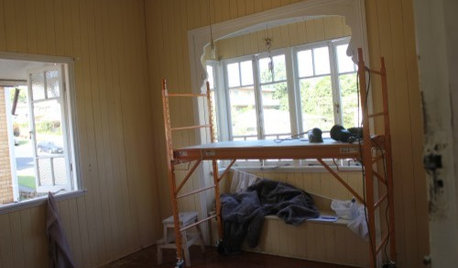Framing questions
olivesmom
10 years ago
Related Stories

DOORS5 Questions to Ask Before Installing a Barn Door
Find out whether that barn door you love is the right solution for your space
Full Story
KITCHEN DESIGN9 Questions to Ask When Planning a Kitchen Pantry
Avoid blunders and get the storage space and layout you need by asking these questions before you begin
Full Story
REMODELING GUIDES13 Essential Questions to Ask Yourself Before Tackling a Renovation
No one knows you better than yourself, so to get the remodel you truly want, consider these questions first
Full Story

GREEN DECORATING8 Questions to Help You See Through Green Hype
With the ecofriendly bandwagon picking up some dubious passengers, here's how to tell truly green products and services from the imposters
Full Story
REMODELING GUIDESConsidering a Fixer-Upper? 15 Questions to Ask First
Learn about the hidden costs and treasures of older homes to avoid budget surprises and accidentally tossing valuable features
Full Story

ORGANIZING4 Questions to Help You Organize Your Favorite Photos
Organize your keeper photos with a system that's just right for you, whether it's in the cloud or you can hold it in your hand
Full Story
LIGHTING5 Questions to Ask for the Best Room Lighting
Get your overhead, task and accent lighting right for decorative beauty, less eyestrain and a focus exactly where you want
Full Story
FEEL-GOOD HOMEThe Question That Can Make You Love Your Home More
Change your relationship with your house for the better by focusing on the answer to something designers often ask
Full StoryMore Discussions








energy_rater_la
worthy
Related Professionals
Bayshore Gardens Architects & Building Designers · Fort Lewis Architects & Building Designers · Four Corners Architects & Building Designers · Lakeland South Home Builders · Prichard Home Builders · West Jordan Home Builders · Chatsworth General Contractors · Los Alamitos General Contractors · Medway General Contractors · Mentor General Contractors · Newington General Contractors · Peoria General Contractors · Pinewood General Contractors · Post Falls General Contractors · Sterling General Contractorsenergy_rater_la
millworkman
methoddesigns
renovator8
energy_rater_la
User
brickeyee
renovator8
brickeyee
energy_rater_la
renovator8
Awnmyown
millworkman
renovator8